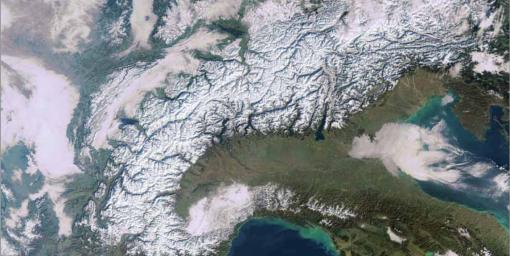On December 21, the Catalans re-elected their parliament, the majority of whose seats returned to the separatist lists (and not the majority of votes). Earlier this week, the Austrian government, on the basis of an idea defended by the FPÖ, relaunched the issue of South Tyrol by offering an Austrian passport to the German-speaking (and Ladin-speaking) inhabitants of the province of Bolzano … Whatever the levels, it is indeed a “systemic” crisis facing Europe, a crisis noted by Christel Hahn in this article written after the meeting of the presidents of the Alpine regions in summer 2012 in Bad Ragaz, Switzerland. The ideas contained in this document are as relevant today as yesterday, especially the crisis in South Tyrol shows that an Alpine space strategy would make sense to respond to growing conflicts. Indeed, why not defuse the debate on the establishment of a toll or common vignette to the Alpine space? Why not seek cooperation with Switzerland, Liechtenstein, Bavaria and Baden-Wuerttemberg as part of a “multi-level governance”? A new step to constructively strengthen the Alpine region. For the attention of the Austrian government Christel Hahn reminds that Visegrad is important, but the Alps, the true heart of Europe, too.
Christel Hahn, Autumn 2012
Last summer (29.6.2012) the leaders of the alpine regions met in Bad Ragaz, Switzerland. In a way this was one of many similar meetings, but it was exceptional, because the number of participating regions had increased, among the participants there were representatives of the Italian Lega Nord and because of this the meeting received some attention in the European press [1] . The meeting was summarized by its chairman (Willi Haag, St. Gallen): “We want to transform the Alps into the heart chamber of Europe” [2] .
The meeting was the “Conference of the Alpine Regions” that happened at the occasion of the regular conference of the “Arge Alp” (an association of alpine regions, that was founded 40 years ago, long before Schengen and the Euro). It adopted a resolution, based on a strategy paper aimed at developing a macro-regional European strategy for the Alps.
The conference was the result of continuous networking within a number of trans-alpine working groups and organizations, which have been established during the different phases of the European integration:
EU: Ten historic steps
1951: The European Coal and Steel Community is established by the six founding members
1957: The Treaty of Rome establishes a common market
1973: The Community expands to nine member states and develops its common policies
1979: The first direct elections to the European Parliament
1981: The first Mediterranean enlargement
1993: Completion of the single market
1993: The Treaty of Maastricht establishes the European Union
1995: The EU expands to 15 members
2002: Euro notes and coins are introduced
2004: Ten more countries join the Union
Alps: The network
![]() Efforts to protect the alpine nature are obviously older than the political integration and lead in 1952, directly after the war, to CIPRA (Commission Internationale pour la Protection des Alpes – International Commission for the Protection of the Alps).
Efforts to protect the alpine nature are obviously older than the political integration and lead in 1952, directly after the war, to CIPRA (Commission Internationale pour la Protection des Alpes – International Commission for the Protection of the Alps).
![]() During the first phase of the European Integration with the European Community (six founding member states) and the EFTA (most of the remaining western European states) the Arge Alp, an organization of leaders of regions in the center of the Alps, was founded in 1972.
During the first phase of the European Integration with the European Community (six founding member states) and the EFTA (most of the remaining western European states) the Arge Alp, an organization of leaders of regions in the center of the Alps, was founded in 1972.
![]() The first European renaissance of 1985-1992 in the time of the dissolution of the iron curtain saw also the establishment of the Europaregion Tirol-Südtirol-Trentino [3] in 1989, a trans-national region built of those parts of Tirol, which had been separated by the treaty of Saint-Germain after the First World War.
The first European renaissance of 1985-1992 in the time of the dissolution of the iron curtain saw also the establishment of the Europaregion Tirol-Südtirol-Trentino [3] in 1989, a trans-national region built of those parts of Tirol, which had been separated by the treaty of Saint-Germain after the First World War.
![]() In the same period, in which the European Union was created through the treaty of Maastricht, the major alpine states signed the Alpine Convention in 1991. The Alpine Conference is the regular meeting of those states.
In the same period, in which the European Union was created through the treaty of Maastricht, the major alpine states signed the Alpine Convention in 1991. The Alpine Conference is the regular meeting of those states.
![]() After the EU was established it set in place the Alpine Space Programme (first beginnings in 1997) as part of its cohesion policy (i.e. regional policy).
After the EU was established it set in place the Alpine Space Programme (first beginnings in 1997) as part of its cohesion policy (i.e. regional policy).
![]() Now, in the time when the expanded EU tries to consolidate into Euroland, all alpine regions joined with the common goal of establishing a Macro-Regional Strategy for the Alps.
Now, in the time when the expanded EU tries to consolidate into Euroland, all alpine regions joined with the common goal of establishing a Macro-Regional Strategy for the Alps.
All these networks are co-existing, exchanging and sharing and thus together form an alpine network, in which the officials working on transnational projects have been cooperating for a long time now, creating a feeling of “Alpine family“ Bernard Soulage, Vice-president of …. And the whole family is involved in the project of a macro-regional strategy for the Alps.
The common link for this group of European regions is its geography, which was shaped when Africa collided with Europe. This collision did not only create the high mountains, but also the surrounding basins and can for example be explored at the Matterhorn (Mount Cervin) with its peak made from gneisses from the African continent: the Matterhorn

As has been recently shown Martin Freksa: Genesis Europas, Ber… the European peoples expanded from Europe’s mountains (Alps, Scandinavian and eastern-European mountain ranges). Whereas the Mediterranean area has seen highly developed cultures since about 5000 years, such a development started north of the Alps only about 2500 years ago. In this early age (Hallstatt culture, expansion of the Roman empire across the Alps, Christianization of Central Europe) the area of the northern lowlands of the Alps and especially the area around the Lake of Konstanz (with the bishop of Konstanz and the monasteries of St. Gallen and Reichenau) was the political, cultural and spiritual center of Central Europe.
After this excurse into distant times, let’s return to the present political development.
The “Alpine Family”
1. CIPRA is a NGO which since 60 years works for a sustainable development of the Alps. It is an umbrella of about 100 member organization with representations in Germany, France, Italy, Liechtenstein, Austria, Switzerland, Slovenia and in Südtirol and its headquarter in Liechtenstein and was the main actor, which helped to create the Alpine Convention. It works with a double strategy: top-down (alpine convention) and bottom-up (projects and initiatives).

2. The Arge Alp was within Europe the first association of state and autonomous units at a level below the nation-states and is basically an organization of regional leaders. It was founded 40 years ago and the initiative came from the leaders of Tirol (Eduard Wallnöfer) and Südtirol (Silvius Magnago) and to a certain extent of Bayern (Alfons Goppel). Its foundation marked the conclusion of the hot phase of the Südtirol conflict between Austria and Italy (which had involved the UN and had also prevented Austria’s earlier accession into the EU) and its europeanisation. The member regions are (founding members in bold): Baden-Württemberg, Bayern (D), Salzburg, Tirol, Vorarlberg (A), Trient, Südtirol, Lombardia (I), St. Gallen, Tessin, Graubünden (CH) . Trient came in 1973, St. Gallen in 1982, Tessin in 1988 and Baden-Württemberg in 1992 [4].

40th anniversary of the Arge Alp[5]
3. The Europaregion Tirol-Südtirol-Trentino is a merger of these three regions into one trans-national region and has in 2011 adopted the legal form of an EGTC (European Grouping of Territorial Cooperation – a legal structure created by the EU). It is another outcome of the europeanisation of the Südtirol-conflict and as can be seen from the history of the Arge Alp really is the nucleus of the alpine integration as France/Germany is the nucleus of the European integration.


European Grouping of Territorial Cooperation
4. The Alpine conference is a regular meeting of the states, which have agreed on the Alpine convention. The first alpine conference happened in 1989 and the alpine convention, which is an international treaty on the comprehensive protection and sustainable development in the Alps between the EEC (later EU) and the 8 alpine states Germany, France, Italy, Lichtenstein, Austria, Switzerland, Slovenia and Monaco, was signed in 1991 (and ratified in the following years). The Alpine convention comprises an area of 190,600 km² and a population of 13.9 millions.

5. In the EU we have on the one hand the European Council (meeting of the head of states) and on the other hand the direct EU institutions (Commission, Parliament …). Those EU institutions have given to the Alps the Alpine Space Programme, which is a transnational cooperation program (Euro-speak: a European Territorial Cooperation – ETC) in the framework of the European Union cohesion policy (a policy aimed at reducing the disparities between the European regions) [6]] . The EU cohesion policy has manifested into a series of 7-year-plans (the last covering 2007-2013 and the upcoming one leading up to 2020) and stands in this last period for about one third (or 347 billion) of the total EU budget [7] . The major part of this money goes into cohesion (i.e. funding “backward” regions) and only a small amount into territorial cooperation [8] , for the Alps this amounts to 130 Million for 2007-2013 [9] . The first beginnings of the Alpine Space Programme date back to1997 and its partner states are those of the alpine convention (except for Monaco). But whereas the Alpine Convention covers only the core alpine area (the alpine arc), the Alpine Space Programme includes also the surrounding lowlands with some important metropolitan areas (like München, Wien, Ljubljana, Milano, Lyon and Zürich) and thus has an area of 390.000 km² and a population of 70 million. It has a permanent secretariat in Innsbruck (with a branch office in Bozen).

6. In a time, when the EU has to redefine itself because of the global crisis and prepares for the next 7-year-plan of 2014-2020, a new concept has been born in EU jargon: Macro-Regional Strategy. It is defined as “an integrated framework that allows the European Union and Member States to identify needs and allocate available resources” [10] . Macro-Regional Strategy is a step from central planning and implementation to decentralized planning and implementation. The EU has already two macro-regional strategies: the Baltic Sea Strategy (approved by the European Council in June 2009) and the Danube Region Strategy (December 2010).
Work to develop a macro-regional strategy for the Alps has been carried out since 2009 through the Arge Alp, the Alpine Conference and the Alpine Space Programme and aims at involving 40 regions of 7 states with a population of 50 million.
Towards a Macro-Regional Strategy for the Alps
In May 2010 a declaration was signed by Salzburg, Tirol, Vorarlberg, Südtirol, Trient, Graubünden and Bayern. The regional leaders of the Arge Alp worked on the strategy during their yearly conferences (41. in Eppan June 2010, 42. in Zell am See July 2011, 43. in Bad Ragaz July 2012). At the XI Alpine Conference (Brdo, March 2011) a working group [11] was installed, that reported to the XII Alpine Conference (Poschiavo, September 2012). The Alpine Space Programme is running since May 2011 an inclusive process for an EU strategy for the Alps with the elaboration of documents by external experts as a basis for stakeholder dialogues [12] . More regions joined the development of the strategy at conferences in Brussels (November 2011) [13] and Grenoble (January 2012), at the Conference of Alpine Regions of Bad Ragaz (July 2012) and at the Conference of Alpine Regions & States during the celebration of the 40th anniversary of the Arge Alp in Innsbruck (October 2012). 2012 was a year of research and debate for the Alps and as a result the network has expanded, the geographical scope of a macro-regional strategy has been defined, content has been developed and influence has been exerted on the EU institutions and the national governments. Austria and France have moved to put the proposal before the European Council. A visible outcome is expected in spring, when an Alpine Space Stakeholder Conference is scheduled for February 21, 2013 in Milano [14] .
The three objectives for a macro-regional strategy for the Alps, that were agreed upon in Bad Ragaz and in which cooperative efforts are expected to be more effective than national solutions are:
![]() Promotion of innovation and competitiveness in this prosperous area
Promotion of innovation and competitiveness in this prosperous area
![]() Common strategies regarding water, energy, agriculture, forestry, environment and climate
Common strategies regarding water, energy, agriculture, forestry, environment and climate
![]() Development of solutions with respect to the increase in trans-Alpine traffic and the accessibility of inaccessible mountain regions.
Development of solutions with respect to the increase in trans-Alpine traffic and the accessibility of inaccessible mountain regions.
And as a conclusion it was seen, that the macro-regionsal strategy for the Alps should provide a frame “which allows the collaboration of all essential levels of government and adminstration” [15] .
Such multi-level governance is actually already happening in the current process: Because the Alps and the surrounding lowlands are a relatively prosperous part of Europe, it is not surprising, that in the situation of the global and European crisis, the regional leaders have put a high weight on the concern to protect the achievements of these regions and have actually included this concern as the main objective into the paper of Bad Ragaz. On the other hand CIPRA and the Alpine Conference are expressing their concern, that their achievements that have culminated in the Alpine Convention should not be diluted and the European Commission tries to manage the unmanageable. All players are concerned about how the money for 2014-2020 will be distributed. To illustrate this process, three voices are documented here:
Luciano Caveri, former president of Valle d’Aosta: “Alpine macroregion is a step beyond the Alpine convention and EU funds: regions will take the floor” [16] .
A press release of CIPRA: “The conversion of the Alpine Convention into an extended Alpine region, the Alpine macro-region, must now be strengthened. The values acquired by means of this unique international treaty must be applied as a minimum standard to the protection and sustainable development of an extended Alpine region. … A new solidarity is needed between the actors in the Alpine arc and the metropolitan areas in the regions surrounding the Alps” [17] .
Johannes Hahn, EU commissioner for Regional Policy: “The Alpine regions have a long experience of working together, and they have some of the best established and mature administrations in Europe. They are well-placed to run any new form of co-operation themselves. There is no need to give a formal role to the European Commission” [18] .
Trends, which shape the Macro-Regional Process
The need to balance the ecology in turbulent times
The continuous need to balance the fragile eco-systems of the Alps is and has been one of the strongest motifs for regional cooperation and integration. The current global systemic crisis is actually a period of big turbulences (political instability, economic insecurity, climatic turbulences) and thus intensifies the need to balance. So in the world, which emerges from the crisis, it’s not enough to rely on existing processes, but we see a necessity for completely new methods and solutions originating from an intensified awareness.
The alpine arc is shaped by its history
1919 saw the dismantling of the Habsburg empire [19] , which originated from the Habsburg in Switzerland, expanded to more regions of the alpine arc (Baden-Württemberg, Vorarlberg, Tirol, Slovenia, Lombardia, Franche-Compté) [20] , moved its center to Austria after the Swiss had liberated themselves, built the eastern European power Austria-Hungaria and provided most of the German emperors from the end of the Staufer up to the end of the Reich. In 1919 Südtirol was given to Italy by the treaty of Saint-Germain.
Because Austria was in a weaker position than Italy after the Second World War, Südtirol stayed with Italy and Italy blocked the realization of the contractually agreed autonomy. The situation escalated into terrorism (with a possible involvement of Gladio) and was resolved through continued negotiations and international pressure on the Italian government in 1972. The regional leaders, who had to give up hope of unification inside Austria, reached a unification of Tirol as a Europaregion. The dynamics of a peaceful resolution of a long conflict made this region a motor of the alpine integration.
The EU is more than the EU
Although the EU as a political entity has well-defined borders, this is not true for its cohesion policy and also not for its macro-regional strategies; they do include many regions, which politically are not part of the EU. This is true for the existing European macro-regional strategies for the Baltic Sea and the Danube area. And in the Alps we have Switzerland (and Liechtenstein) as an integral and pro-active part of all alpine networks. This gives an additional strength and dynamics to the alpine network.
The pressure for more federal and decentralized structures
The many borders, the small size of Austria and Switzerland and the specific questions, that need to be resolved, create a tendency of the regional leaders to act as “head of states” with a network of “foreign relations” [21] . This is encouraged by the federal/decentralized structures of Switzerland, Germany, Austria and Italy. Each of these states has a unique political system, the Swiss one being the most federal and direct democratic, where the cantons are allowed a “small foreign policy” (kleine Außenpolitik). Switzerland, Germany and Austria have a second parliamentary chamber, whose members are determined by the Länder/cantons. In Italy a process to convert the constitution into a federal constitution is on hold, but the system has been decentralized in recent years (autonomous regions are keeping 90% of their income). And in France there is a growing pressure to move into this direction, which also can be seen from the expansion of the alpine network into France.
Prosperity of Alpine Regions
The Alps are a group of European region with a relatively homogenous economic structure, which is caused by a relatively homogenous natural environment. Typical for this area is not large-scale mass production, but technological innovation through networks of medium-size industries and universities. Many factors have contributed to this prosperity: political stability and the resulting influx of capital, the strength that results from overcoming natural challenges, the location in the center of Europe and specific historical and political conditions. This has led in Italy as well as Germany to a situation, where the leaders of the northern regions of Italy and the southern regions of Germany contradict their national governments. The Italian Lega Nord and the Bavarian CSU are very different in their political program, but similar in the point, that they give continuous headaches to their respective national governments.
Anticipation of the Future Development of the Process
The emergence of the macro-regional strategy for the Alps is clearly a part of the transition described by Franck Biancheri in his book “World Crisis: The Path to the Word Afterwards”. His findings are used here to analyze the process:
Structure and size
The press release of CIPRA of August 2012 [22] says: “The train for an Alpine macro-region has now left the station; none of the major participants wants to miss it.” Other voices are more skeptical and say, that one cannot foresee, what is going to be decided in Brussels. Others say (and we shall join here), that looking at such a decision is not the most important, more important is to look at the existing network. This network is existing and working, has strengthened itself through the common process of the last two years and looks pretty mature. This is very interesting, because it shows that in Euroland (a term used here for an EU transformed through the global crisis) processes don’t move top-down, but in networks and are actually processes of self-organization [23] .
There is a question, whether the metropolitan areas should be part of the Alpine macro-region. They do not really belong to the mountains, but they do belong to the area, that was shaped by a common history and they want to participate. So they will be a part, but nevertheless the borders of the Alpine macro-region might be flexible, for example if the political situation in participating regions is changing [24] .
It has to be noted here, that the alpine network is basically a network of regional politicians and NGOs and thus is still part of “old world”. Among the citizens we see a growing distrust to all “officials”, but on the other hand a historically strong identification with their regions [25] .
Promotion of innovation and competitiveness in this prosperous area
The inclusion of this objective is nothing new for an EU with market liberal principles, but shows, that the objectives for the EU regional policy need to be adjusted. From a world, which believes in “making everybody equal” and solving problems by pouring money from a central watering can, we are moving into a world that acknowledges everybody’s uniqueness and consists of self-sufficient communities. In this world we will not make everybody equal (like Procrustes, who cut people’s legs to fit them into his iron bed), but only make sure, that everybody has equal opportunities and can develop according to his specific talents. Also in this world parliaments (which are the expression of the idea, that everybody is equal) will be of less importance and networks of experts will gain importance.
For prosperous regions this does not have to mean, that they will get the money, which now goes to poor regions, but that they get the space to develop according to their capabilities. This will not be possible without changes in the money system, to ensure, that not the market, but the needs of the communities and regions determine capital flow [26] .
Common strategies regarding water, energy, agriculture, forestry, environment, climate
Again we are seeing, that we are moving from the world of the watering can into a world, in which the environment is not seen as a problem to be solved, but as an ecosystem of which we are part of and in which we have to do our part of balancing the whole system [27] , from a world of systems and structures into a world in which all needs are balanced.
Also in this world of tomorrow with its growing interdependence, questions, that have been spared up to now, have to be tackled. These questions, where politics is not looking or not moving, are more and more strongly raised by citizens’ movements. One such question comes from the plans of Switzerland to build a permanent disposal site for nuclear waste in the northern lowlands of the Alps, which is definitely not a geologically stable region. Although Switzerland is responsible for its nuclear plants, this question can only be tackled by the whole community.
Development of solutions with respect to the increase in trans-Alpine traffic and the accessibility of inaccessible mountain regions
Again we are seeing that we are moving from a world of systems and structures into a world in which the needs of the citizen are valued. Here Switzerland with its direct democracy is a good example. The Swiss voted against high-speed trains (because they do not make sense in a small mountainous country) and instead an exemplary railway system was developed [28] . As good practices are being spread by the network, there is a chance that this good example is extended to the whole alpine arc. To replace the national car vignettes (high way toll) by one Alpine Car Vignette will be very popular with the citizens. In this way, acceptance will be raised with the citizens (who need to pay only once) and incentives will be made to integrate the road planning and financing.
Christel Hahn
[1] Source : PressEurop, 03/07/2012
[2] Sources : Arge Alp, 29/07/2012 ; Arge Alp, 29/07/2012
[3] I am using here the English names for states, but for the regions I stay with the genuine or the German name.
[4] Geschichte der österreichischen Bundesländer seit 1945, Liebe auf den zweiten Blick von Herbert Dachs, Ernst Hanisch und Robert Kriechbaumer von Böhlau, Wien 1998
[5] 40th anniversary of Arge Alp, see video
[9] Source : Alpine-Space.eu
[10] Source : Alpine-Space.eu
[11] Source : Alpine Convention
[12] Source : Alpine-Space.eu
[13] Source : Bayerisches Staatsministerium für Umwelt und Gesundheit
[14] Source: Alpine-Space.eu
[18] Source : Alpine-Space.eu
[19] An empire in which at its peak “the sun never sat” and which grew through marriages: “Alii bella gerunt, tu felix Austria nube!”
[21] An interesting example of this trend: Lothar Späth, a former prime minister of Baden-Württemberg, started “4 Motors for Europe”, a collaboration of Baden-Württemberg, Catalonia, Lombardia and Rhône-Alpes. Source : Der Spiegel
[23] This also shows that a Euroland constitution should be nothing like the failed EU constitution, but a very short document, that does not try to formalize everything.
[24] The council of Lombardia of Roberto Formigioni, has been shaken by a corruption scandal. Source : Financial Times, 14/10/2012
[26] Switzerland is the first country where a people’s referendum on a reform of the monetary system is being prepared, see VollGeld
[27] A very highly developed process is EMAS (European Eco-Management and Audit Scheme). It is a self-improving cycle, where an organization defines objectives and then continually improves on these objectives
[28] The protesters in Stuttgart would actually like to replace Deutsche Bahn by SBB.


 LEAP2040 Toutes les informations et archives Europe2040
LEAP2040 Toutes les informations et archives Europe2040



